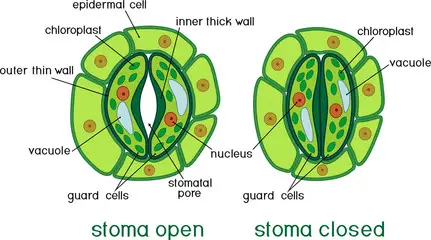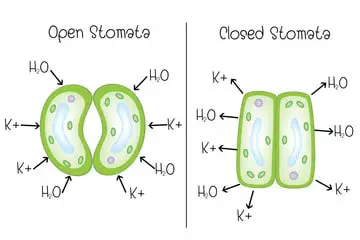Transpiration is the movement of water from the plants into the air. But if you are asked to define what is transpiration, you can say it as
“The loss of water in the form of vapor from the aerial parts of the plants into the atmosphere.”
In spite of the loss of water by transpiration, plants maintain their water balance efficiently.
Types of transpiration
The loss of water from plants into the atmosphere occurs from the stomata, cuticle and also lenticels. Based on this transpiration is classified into three types as
1. Stomatal transpiration
2. Cuticular transpiration
3. Lenticular transpiration
Stomatal transpiration: This accounts for 95% of total transpiration in plants. The water vapor is lost through tiny openings called stomata. In healthy plants, the stomata are open and closed as per need.

But in xerophytes (desert plants) these stomata are shrunken to minimize the water loss from the plant. The stomata are present in the epidermis of leaves and young stems.
Cuticular transpiration: The uppermost layer of plants is called the cuticle. It is hard and up to 2% of total water loss occurs from here. In desert plants, the cuticle is very thick to minimize water loss.
Lenticular transpiration: This involves the loss of water from the lenticels. Lenticels are fine pores present on the bark of old stems and pericarps of woody fruits. They can be seen in older plant parts too. These minute openings are formed due to loosely arranged cells. It is estimated that the total loss of water by this route accounts for just 0.1% of total transpiration.
Transpiration process
The transpiration is controlled by guard cells of stomata. These guard cells surround the stoma or opening of the stomata.
When the guard cells absorb water, they swell leading to the opening of the stoma. When the guard cells lose water, they become flaccid and the stoma is closed.
In general, stomata open in the day and are closed at night.
Mechanism of stomatal opening
1. Bowling’s hypothesis: This theory is proposed by bowling in the year 1984. As per him, K+ (potassium ions) of guard cells acts as osmoticum for guard cells. That is when the K+ ion enters the guard cells, the stomata open. If the K+ ions come out of the guard cells, the stomata are closed.
That is when the K+ ion enters the guard cells, the stomata open. If the K+ ions come out of the guard cells, the stomata are closed.
2. Starch and sugar hypothesis: This was proposed by Lloyd in 1908 and later supported by Sayre in 1926. As per this theory, low CO2 and high pH levels lead to the opening of stomata. While high CO2 levels with low pH lead to the closure of stomata.
When the pH is low sugar is converted to starch and when pH is high, starch converts to sugar.
The formation of sugars in guard cells leads to a decrease in osmotic potential and water potential. Hence, guard cells absorb water from subsidiary cells to become turgid (swollen).
The formation of starch leads to an increase in osmotic potential and water potential. Due to this, guard cells give out water and become flaccid.
When guard cells are turgid, the stoma opens and when the guard cells are flaccid, the stoma closes.
3. Zelitch hypothesis: This hypothesis states that the formation of glycolic acid at a low concentration of CO2 in guard cells leads to the opening of stomata.
Advantages of transpiration
1. The ascent of sap: Transpiration helps in the development of pressure. This pressure aids in the rise of sap, i.e., upward movement of nutrients and water from roots to the top of the plant. Thus it aids transportation in plants.
2. Temperature regulation: Transpiration helps to regulate plant temperature. In animals, a phenomenon called sweating helps to remove heat from the body to the outside. Similarly, in-plant water is removed as a vapor to regulate the internal heat of the plant.
3. The mass flow of mineral ions: Mineral ions from the soil can move to the upper parts of the plant due to transpiration. Since these ions are mixed with water, they move along with it to the entire plant tissues.
4. Passive absorption of water: Removal of water from the top creates pressure for passive absorption of it from roots.
Disadvantages of transpiration
1. Loss of water: Plants lose the maximum amount of water absorbed from the roots due to transpiration.
2. Wilting and damage: When there is water deficiency, the evaporation of water causes wilting and injury to the plant. When the rate of transpiration is high, the chances of wilting are also higher.
Hence, transpiration is called “a necessary evil in plants” as it is both supportive and destructive to the plants.
